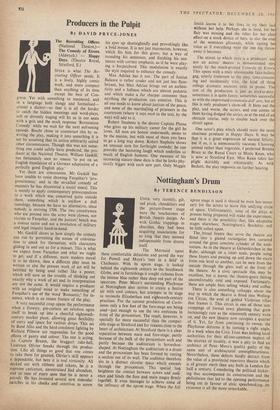Nottingham's Drum
By TERENCE BENDIXSON UNTIL very recently, gilt, red plush, chandeliers and the picture-frame stage were the touchstones of British theatre design. As with Gothic trappings in churches, they had been acquiring associations for so long that they seemed indispensable from drama itself.
The Mermaid upset these comfortable delusions and paved the way for Powell and Moya's 'tent in a field' in Chichester. With its apron stage, it looked behind the eighteenth century to the Southwark Globe, and in furnishings it sought richness from the intense blue rather than deep red part of the spectrum. Peter Moro's outstanding Playhouse at Nottingham also strives to create a festive air with cool colours, but attempts in its stage to reconcile Elizabethan and eighteenth-century practices. For the current production of Corio- lanus only a few feet of the fore-stage are being used—just enough to use the two entrances in front of the proscenium. The result, however, is spatially far more successful than the compar- able stage at Stratford and for reasons close to the heart of architecture. At Stratford there is a clear separation between main and fore-stage, partly because of the bulk of the proscenium arch and partly because the auditorium is horseshoe- shaped. At Nottingham the auditorium is a drum and the proscenium has been formed by cutting a section out of its wall. The audience therefore sits in a distinct circular space which extends through the proscenium. This spatial link heightens the contact between actors and audi- ence and binds the fore and main stages firmly together. It even manages to achieve some of the intimacy of the apron stage. When the full
apron stage is used it should be even less neces- sary for the actors to leave this unifying circle of space. Unfortunately, none of the plays at present being prepared will make the experiment, and there is the possibility that like adaptable stages elsewhere, Nottingham's flexibility will be little called upon.
The, broad foyers that serve the theatre are fitted into a glazed rectangular box corseted around the great concrete cylinder of the audi- torium. As in the theatre at Gelsenkirchen in the Ruhr, although on a tinier scale, people using these foyers and passing up and down the stairs from one level to another, can be seen from the outside through the glass wall at the front of the theatre. As a civic spectacle this may be excellent, but it leaves the theatre-goers feeling uncomfortably cold and exposed. Fortunately, there are ample bars selling whisky and coffee.
There is also something unhappy about the way in which the theatre is fitted into Welling- ton Circus, the oval of gabled Victorian villas that frames it. This circus is one of those out- croppings of formal town planning that grew increasingly rare as the nineteenth century wore on, and the new theatre now occupies a quarter of it. Yet, far from continuing its sweep, the Playhouse deforms it by turning a right angle. In a week when the Civic Trust was lashing local authorities for their all-too-common neglect of the niceties of locality, it was a pity to find an architect of Peter Moro's quality guilty of the same sort of architectural unneighbourliness. Nevertheless, these defects hardly detract from the value of a provincial repertory theatre which is of greater merit than any built in London for half a century. Considering the political bicker- ing that accompanied its construction and the philistinism that led to the opening performance being cut in favour of civic speechmaking, its existence is all the more remarkable.






























 Previous page
Previous page